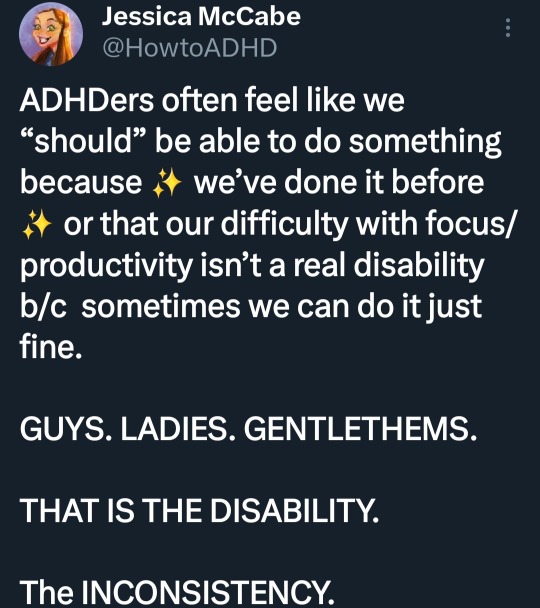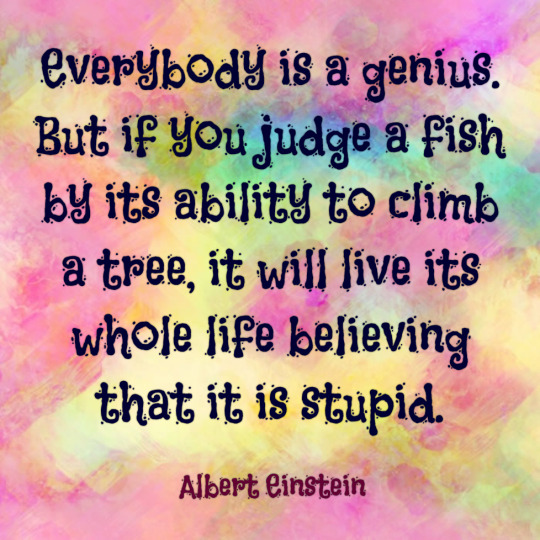#AttentionDeficitHyperactivityDisorder
Explore tagged Tumblr posts
Text

Saturday, July 15, 2023 ADHDers often feel like we 'should' be able to do something because ✨ we've done it before ✨ or that our difficulty with focus/productivity isn't a real disability b/c sometimes we can do it just fine.
GUYS. LADIES. GENTLETHEMS.
THAT IS THE DISABILITY.
The INCONSISTENCY. - Jessica McCabe, @howtoadhd
~~~~~~~~~~~~~~~~~~~~~~~~~~~~~~~~~~~~~~~~~~~
The image was, initially, shared to Instagram; check it out here! Interested in seeing where the image came from? If so, check it out here! Watch MonriaTitans on Twitch and YouTube!
#jessicamccabe#howtoadhd#adhd#attentiondeficithyperactivitydisorder#adhder#attentionregulation#attentiondisregulation#disability#difficult#difficulties#focus#productivity#inconsistency#neurodivergent#neurodivergence#disabilityawareness#disabilitypridemonth#jessicamccabequote#jessicamccabequotes#learnsomethingneweveryday#becomesmartereveryday#monriatitans#mt#actuallyneurodivergent#fightstupidity#fightignorance
5 notes
·
View notes
Text
Các trung tâm can thiệp trẻ tăng động giảm chú ý ở Hà Nội uy tín, có danh tiếng tốt thường được đông đảo phụ huynh ưu tiên lựa chọn đưa con em mình đến thăm khám. Tại đây, các chuyên gia sẽ tiến hành kiểm tra, đánh giá tình trạng của bé để xây dựng chương trình can thiệp phù hợp. Để con yêu của bạn phát triển bình thường, có khả năng kiểm soát tốt hành vi và hòa nhập với cộng đồng, hãy đưa bé đến ngay 10 trung tâm dưới đây.
3 notes
·
View notes
Text
The 12 Types of ADHD
ADHD (Attention Deficit Hyperactivity Disorder) is often misunderstood as a single condition that only affects children with hyperactivity. However, research—especially from Dr. Daniel Amen—suggests that ADHD has multiple subtypes, each with its own distinct characteristics. Understanding these subtypes can help individuals recognize patterns in their own behavior and find better coping strategies.
1. Classic ADHD
This is the most commonly recognized type of ADHD, featuring classic symptoms of inattention, hyperactivity, and impulsivity. People with Classic ADHD often struggle with focus, frequently interrupt conversations, and act without thinking.
Symptoms:
Easily distracted
Impulsive behavior
Restlessness and difficulty sitting still
Difficulty following through with tasks
Best Strategies:
Regular exercise to burn off excess energy
Structured routines and schedules
External accountability (coaches, mentors, or apps)
2. Inattentive ADHD (ADD)
Unlike Classic ADHD, individuals with this subtype are not hyperactive. Instead, they struggle with sustaining attention, organization, and memory. They may be seen as "daydreamers" rather than disruptive.
Symptoms:
Difficulty focusing for extended periods
Forgetfulness and losing items frequently
Trouble following multi-step instructions
Often appears lost in thought
Best Strategies:
Using alarms, reminders, and checklists
Breaking large tasks into smaller steps
Brain-stimulating activities like puzzles or reading
3. Over-Focused ADHD
This subtype is characterized by an inability to shift attention, leading to obsessive thoughts, difficulty transitioning between tasks, and an intense focus on specific topics of interest.
Symptoms:
Gets "stuck" on thoughts or activities
Struggles with flexibility in thinking
Overthinks or ruminates on problems
Becomes irritated when routines are disrupted
Best Strategies:
Learning cognitive flexibility techniques
Engaging in mindfulness or meditation
Setting clear boundaries for tasks
4. Temporal Lobe ADHD
This type involves emotional instability, impulsivity, and, in some cases, aggressive or oppositional behavior. It is linked to irregular activity in the temporal lobes of the brain, which govern memory and emotional regulation.
Symptoms:
Sudden mood swings
Angry outbursts or irritability
Poor memory recall
Sensitivity to criticism
Best Strategies:
Therapy or counseling to improve emotional regulation
Journaling to process emotions
Anger management techniques
5. Limbic ADHD
People with Limbic ADHD often experience chronic low energy, sadness, and a lack of motivation. It overlaps with depression but is uniquely tied to ADHD-related executive function issues.
Symptoms:
Chronic feelings of sadness
Low motivation and energy levels
Negative self-talk
Difficulty experiencing joy
Best Strategies:
Regular exercise and sunlight exposure
Engaging in hobbies and social activities
Addressing negative self-perception through therapy
6. Ring of Fire ADHD
This is an intense, emotionally-driven type of ADHD where individuals experience extreme mood fluctuations, anxiety, and sensory overload.
Symptoms:
Intense emotional reactions
Sensory sensitivity (lights, sounds, textures)
Racing thoughts and constant internal dialogue
Overwhelmed by too much stimulation
Best Strategies:
Reducing environmental stressors
Practicing deep breathing and relaxation techniques
Establishing structured downtime
7. Anxious ADHD
As the name suggests, this subtype is marked by excessive worry, nervousness, and physical symptoms of anxiety. People with Anxious ADHD tend to overanalyze situations and fear making mistakes.
Symptoms:
Overthinking and excessive worry
Avoidance of social situations due to fear of judgment
Physical symptoms like headaches or stomach aches
Difficulty sleeping due to racing thoughts
Best Strategies:
Practicing self-compassion and challenging negative thoughts
Engaging in relaxation techniques like yoga or deep breathing
Avoiding caffeine and other stimulants
8. Depressed ADHD
This type combines ADHD symptoms with persistent feelings of sadness, guilt, and low self-worth. Individuals may struggle with motivation and often feel overwhelmed by daily life.
Symptoms:
Chronic low mood
Loss of interest in activities
Fatigue and sleep disturbances
Feelings of worthlessness
Best Strategies:
Therapy or counseling for mood regulation
Regular physical activity to boost dopamine levels
Setting small, achievable goals
9. Oppositional Defiant ADHD
This subtype is characterized by defiance, resistance to authority, and difficulty accepting rules. It is common in children and adolescents but can persist into adulthood.
Symptoms:
Frequently arguing with authority figures
Difficulty accepting criticism
Intense need for control
Impulsivity leading to conflict
Best Strategies:
Practicing self-awareness and self-control techniques
Using logic-based decision-making frameworks
Seeking mentorship or coaching
10. Combination ADHD
A mix of inattentive and hyperactive-impulsive traits, making it one of the most complex forms of ADHD.
Symptoms:
Alternates between restlessness and inattention
Impulsivity combined with forgetfulness
Struggles with both organization and sitting still
Can hyperfocus on some tasks but ignore others
Best Strategies:
Structured time management techniques
Medication or therapy for balancing symptoms
Finding work and hobbies that align with natural energy cycles
11. Sluggish Cognitive Tempo (SCT)
A controversial but increasingly recognized ADHD subtype, SCT involves slow mental processing, brain fog, and difficulty keeping up with conversations.
Symptoms:
Slow response times in conversations
Trouble processing information quickly
Low motivation and energy
Often lost in thought
Best Strategies:
Using visual and audio reminders
Stimulant therapy (if prescribed)
Engaging in stimulating and interactive activities
12. High-Energy ADHD
This is a subtype where individuals have extreme levels of energy, making them highly productive but also prone to burnout and exhaustion.
Symptoms:
High energy but inconsistent focus
Impulsiveness leading to rapid decision-making
Difficulty winding down
Jumping from one project to another
Best Strategies:
Practicing work-life balance
Setting realistic goals
Using physical outlets for excess energy
Final Thoughts
Understanding the different types of ADHD can provide clarity and guidance for those who struggle with focus, impulsivity, and emotional regulation. Whether you recognize yourself in one category or several, the key is finding tailored strategies that work for your unique brain chemistry.
#ADHD#ADHDSubtypes#AttentionDeficitHyperactivityDisorder#ADHDSymptoms#ADHDTypes#MentalHealth#ADHDAwareness#ADHDTreatment#ADHDEducation#OverFocusedADHD#InattentiveADHD#HyperactiveADHD#ExecutiveFunctioningADHD#AnxiousADHD#LimbicADHD#RingOfFireADHD#SensoryProcessingADHD#ADHDSupport#ADHDTips#ADHDCommunity#new blog#today on tumblr
1 note
·
View note
Photo

ADHD: A Surprising Evolutionary Advantage? | CeBoz.com
New research suggests that ADHD traits may have been beneficial for our ancestors during foraging.
0 notes
Text
0 notes
Text
youtube
Call : +917997101303 | Whatsapp : https://wa.me/917997101505 | Website : https://fidicus.com
Vasopressin Deficiency Behind Autism Spectrum Disorder Symptoms? | Treatment Cure Relief Medicine |
Discover the shocking connection between vasopressin deficiency and Autism Spectrum Disorder (ASD). In this eye-opening video, we explore how low levels of the neuropeptide vasopressin may impact social behavior, communication, and emotional regulation—key traits in ASD. Backed by emerging scientific studies, this video sheds light on the biological factors influencing autism. Don’t miss this powerful insight into brain chemistry and behavior.
Dr. Bharadwaz | Autism ADHD | Health & Fitness | Homeopathy, Medicine & Surgery | Clinical Research
#Vasopressin #AutismSpectrumDisorder #ASDResearch #BrainChemistry #AutismScience
#DrBharadwaz #Helseform #Fidicus #Clingenious
#ClingeniousHealth #HelseformFitness #FidicusHomeopathy #ClingeniousResearch
#FidicusAutism #Autism #AutismSpectrumDisorder #ADHD #AttentionDeficitHyperactivityDisorder #ADD #AttentionDeficitDisorder
#Treatment #Cure #Prevent #Relieve #Medicine
#AlternativeTherapy #AdjuvantTherapy #AlternativeMedicine #AlternativeSystem
Speciality Clinic Fidicus Autism highest success with homeopathy Enhance Communication | Improve Cognition | Stabilize Emotion
0 notes
Text

ANNOUNCEMENT - 09/30/2023: October's Cause of the Month
Attention Deficit Disorder Association (ADDA)
With September, and Library Card Sign-Up Month, coming to an end, a new cause to raise awareness of is in order. If you missed the quotes for September, you can see them here! October brings ADHD Awareness Month. So, for October 2023 (and every October, to be frank), I will be sharing quotes about ADHD (Attention Deficit Hyperactivity Disorder). In…
View On WordPress
#adda#ADHD#adhdawareness#adhdawarenessmonth#alberteinstein#announcement#attentiondeficitdisorderassociation#attentiondeficithyperactivitydisorder#becomempowered#becomesmartereveryday#bempowering#Educational#educationalpost#educationalposts#genius#learnsomethingneweveryday#MonriaTitans#monriatitanswgs#Neurodivergence#neurodivergent#neurodiverse#neurodiversity#stupid#The Weekend Game Show#WGS
1 note
·
View note
Photo

ADHD Medication Shortage: Struggles and Consequences | CeBoz.com
ADHD Medication Shortage Impacting Lives
1 note
·
View note
Text
youtube
Call : +917997101303 | Whatsapp : https://wa.me/917997101505 | Website : https://fidicus.com
Neuronal Migration Defects in Autism Spectrum Disorder, ASD. | Treatment Cure Relief Medicine |
This video explains how defective neuronal migration during early brain development contributes to Autism Spectrum Disorder (ASD). Understand the role of abnormal neuron positioning, brain structure formation, and how it may impact behavior, learning, and sensory processing in children with ASD. Learn how homeopathy offers a supportive, holistic approach in managing neurodevelopmental disorders like autism.
Dr. Bharadwaz | Autism ADHD | Health & Fitness | Homeopathy, Medicine & Surgery | Clinical Research
#Autism #NeuronalMigration #ASD #BrainDevelopment #HomeopathyForAutism
#DrBharadwaz #Helseform #Fidicus #Clingenious
#ClingeniousHealth #HelseformFitness #FidicusHomeopathy #ClingeniousResearch
#FidicusAutism #Autism #AutismSpectrumDisorder #ADHD #AttentionDeficitHyperactivityDisorder #ADD #AttentionDeficitDisorder
#Treatment #Cure #Prevent #Relieve #Medicine
#AlternativeTherapy #AdjuvantTherapy #AlternativeMedicine #AlternativeSystem
Speciality Clinic Fidicus Autism highest success with homeopathy Enhance Communication | Improve Cognition | Stabilize Emotion
0 notes
Photo

Hank's ADHD is kicking in. #alexha #digitalart #digitaldrawing #oc #originalcharacter #artistsoninstagram #hank #adhd #attentiondeficithyperactivitydisorder https://www.instagram.com/p/B2W0k8rAsu8/?igshid=b0gjwoiwwghp
#alexha#digitalart#digitaldrawing#oc#originalcharacter#artistsoninstagram#hank#adhd#attentiondeficithyperactivitydisorder
1 note
·
View note
Video
youtube
What is ADHD?
Attention Deficit Hyperactivity Disorder (ADHD) is a chronic neurodevelopmental disorder that affects children and adults. This disorder is identified by symptoms such as trouble paying attention, impulsive behavior, and hyperactivity, which can manifest itself in varying degrees and combinations in individuals. ADHD is believed to originate from a combination of genetic and environmental factors, and is often diagnosed in childhood. While medication and behavioral therapy can help manage the symptoms, there is no known cure for ADHD. Understanding the complexity of this disorder is essential for clinicians to provide effective treatment and support for individuals diagnosed with ADHD.
#youtube#shorts#short#shortvideo#adhd#attentiondeficithyperactivitydisorder#children#childrens#hyperactivity#hyperactive#childhood#health#mentalhealth#kids#condition#behavior
0 notes
Photo

ADHD AWARENESS QUOTE 1 OF 3 Friday, October 21, 2022
"Stating the obvious (to those who have it), 'Attention deficit hyperactivity disorder' is a horrible name.
We don't have an attention 'deficit,' we have unregulated attention.
I feel we need to add '&' to it to emphasize the fact our unregulated attention and the hyperactivity are separate issues.
So, I believe we should change the name to 'Unregulated Attention & Hyperactivity Disorder' (UAHD)
What do you think? - MonriaTitans
~~~~~~~~~~~~~~~~~~~~~~~~~~~~~~~~~~~~~~~~~~~~~~~~
Made with the Quotes Creator App. See the original post on Instagram! Watch WGS on Twitch and YouTube!
#monriatitans#adhd#whatdoyouthink#educational#opinion#opinonpost#randomthought#namechange#name#attentiondeficit#unregulatedattention#hyperactivity#gettothepoint#attentiondeficithyperactivitydisorder#unregulatedattentionandhyperactivitydisorder#uahd#monriatitansquote#monriatitansquotes#adhdawareness#adhdawarenessmonth#educationalpost#educationalposts#learnsomethingneweveryday#becomesmartereveryday#becomempowered#bempowering#theweekendgameshow#wgs#quotescreatorapp
2 notes
·
View notes
Text
Health Literacy Among Children With Special Health Care Needs

Children with special health care needs (CSHCN) often require more services than other children their age, and this can be expensive. To better understand how parental health literacy affects the care of CSHCN, a research team conducted a review of 13 studies from 1998 to 2014. further assessment of the relationship between health literacy and health care utilization and cost, and (4) assessment of parental/caregiver health literacy in the inpatient care setting. Read the full article
#AttentionDeficitHyperactivityDisorder#ChildHealthOutcome#ChildWithSpecialHealthCareNeed#FunctionalHealthLiteracy#HealthLiteracy
0 notes
Photo

Attention-deficit/hyperactivity disorder. https://bedlamitepublications.wordpress.com
#lutieloo#pauljameswriting#adhd#attentiondeficithyperactivitydisorder#art#illustration#digitalmedia#digitaldesign#digitalart#photoshop#commision
1 note
·
View note
Text
#ADHD#Americanfootballer#Americanquarterback#asatruefreshman#Attentiondeficithyperactivitydisorder#BocaRaton#Bowl#BYU#MVP#NationalFootballLeague
0 notes
Photo

How Does A Child With Attention Deficit Hyperactivity Disorder View The World? Attention Deficit Hyperactivity Disorder is an illness that begins in childhood, and often persists through adulthood. Read more
0 notes